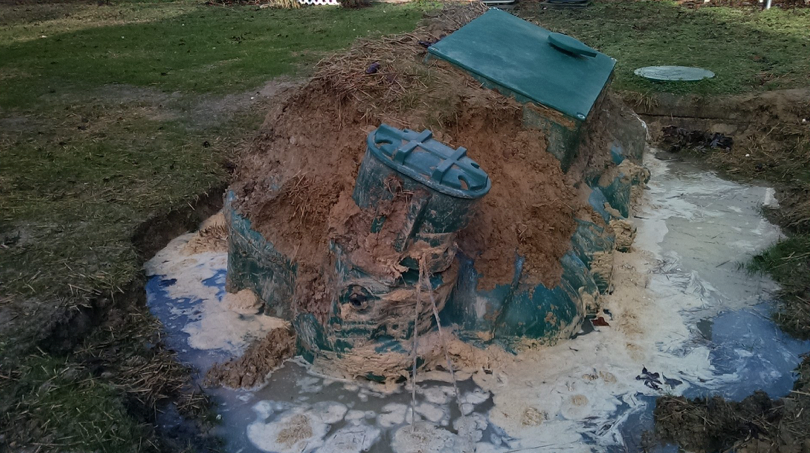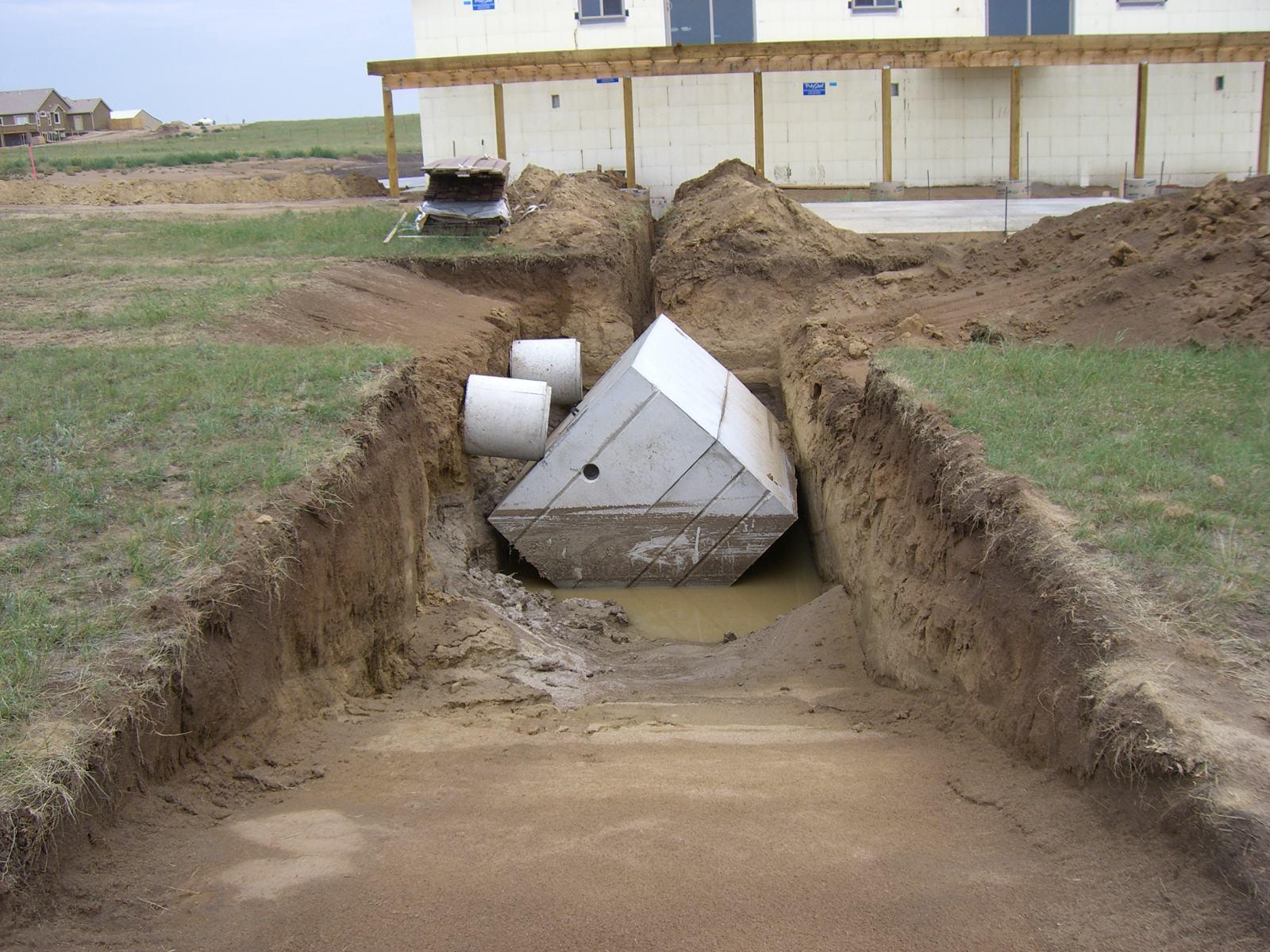Interested in Septic Tanks?
Get Septic Tanks articles, news and videos right in your inbox! Sign up now.
Septic Tanks + Get AlertsWhen installing any sort of tank, media filter or aerobic treatment unit into a high water table or an area prone to flooding, designers and installers must consider if it will remain stable. Then the design plans should specify installation details for implementing anti-floatation measures.
Any tank or buried structure that weighs less than the water displaced will float when empty. To ensure a tank will not float when in saturated soil, a buoyancy analysis should be conducted. In order to carry out the analysis, you must know the weight of the empty tank, the weight of the minimum amount of water and media in the tank, the weight of the soil directly above the tank, and the weight of the maximum volume of water that is displaced (the buoyant force).
Below is a step-by-step example of how to calculate if tank stability is a concern. The calculation is for a septic tank, but the same calculation could be done for media filter or an ATU.
Step 1: Calculate the weight of water displaced by the tank (buoyant force B). The buoyant force is the weight of water that would be displaced by the tank. The conservative approach is to assume that the tank could potentially be fully submerged in saturated soil. In other words, it is the total volume of the tank (in cubic feet) multiplied by the specific weight of water: 62.4 pounds per cubic foot.
Example:
A 600-gallon round tank with no riser has an outside diameter of 67 inches and a height of 65 inches.
Volume of the tank = 3.14 x (33.5 in./12 in./ft)2 x (65 in./12 in./ft) = 132.6 ft3
Weight of water displaced = 132.6 ft3 x 62.4 lbs/ft3 = 8,274 lbs
In a situation in which the tank is only partially submerged or partially surrounded by saturated soil, the submerged depth must be calculated first. The submerged depth is equal to the elevation of the seasonal groundwater table above the tank bottom minus the elevation of the tank bottom. The displaced volume is the bottom area of the tank multiplied by the submerged depth. The uplift created from the submerged tank is then the displaced volume of water multiplied by the density of water.
Step 2: Calculate or look up the weight of the tank (WT). The weight of the tank can be obtained from the manufacturer or calculated. The weight can be calculated by multiplying the volume (in cubic feet) by the specific weight of material making up the tank. For this example, the manufacturer-supplied weight is 5,430 pounds.
Step 3. Calculate the weight of the water in the tank (WW). The greatest risk for floatation occurs when the tank is empty. Therefore, the most conservative approach assumes that there is not water in the tank. This could occur when the system owner has the tank pumped. In the case of a dosing tank, there is typically always a certain level of water maintained below the pump-off level. The weight of the water in the tank can be found by multiplying the depth of the water (in feet) by the interior area of the bottom of the tank (in cubic feet) and then multiplying that by the density of water (62.4 pounds per cubic foot).
Example:
A dosing tank that always has 12 inches of water in the tank.
Area of the bottom of the tank = 3.14 x (30.5/12 ft)2 = 19.6 ft2
Volume of water in the tank = 19.6 ft2 x 1 ft = 19.6 ft3
Weight of water = 19.6 ft3 x 62.4 lbs/ft3 = 1,223 lbs

Step 4. Calculate the weight of the soil cover (WS). Septic tanks and some dosing tanks are buried with soil. The weight of the soil contributes to the downward forces on the tank. In the worst-case scenario when the soil above the tank is saturated, some of the downward force generated by the weight of the soil is counteracted by the upward buoyant force of the water displaced by the soil. The net downward force can be found by multiplying the volume of soil above the tank lid by the difference between the specific weight of the soil and the specific weight of water.
The volume of the soil is found by multiplying the area of the top of the tank by the depth of soil cover. The density of the soil is dependent on the soil type. For example, a sandy soil might have a specific weight around 120 pounds per cubic foot and a clay soil has a specific weight of about 90 pounds per cubic foot. Risers on the tank displace soil and develop an empty volume over the tank. This empty volume needs to be subtracted from the potential volume on top of the tank to get the actual volume of soil on top of the tank.
Example:
The specific weight of the soil is 100 pounds per cubic foot. The tank has 1 foot of soil cover.
Volume of soil above the tank = 3.14 x (33.5 in./12 in./ft)2 x 1 ft = 24.4 ft3
Weight of soil over tank = 24.4 ft3 x (100 lb/ft3- 62.4 lb/ft3) = 917 lbs
Step 5. Evaluation of net forces. The weight of the tank, any water in the tank, and the weight of the cover soil create a downward force. In order to prevent the tank from rising, the total downward force must be greater than the buoyant force. In simple terms, the water in the soil around the tank pushes the tank up and the weight of the tank and soil hold it down. If (WT + WW+ WS) x 0.90 > B, then the tank should not float. (Note: B is the buoyant force calculated in Step 1.)
The 90% multiplier is a safety factor that is incorporated into the equation. This safety factor can be adjusted based on your best professional judgment. If the buoyant force is greater than the total downward forces, then countermeasures must be taken to ensure the tank does not float.
Example:
(WT + WW+ WS) = 5,430 lbs + 1,223 lbs + 917 lbs = 7,570 lbs
7,570 lbs x 0.90 = 6,813 lbs
B = 8,274 lbs
(WT + WW+ WS) x 0.90 < B so countermeasures do need to be taken in order to compensate for the extra 1,461 pounds of buoyant force.
For this example, if the anti-floatation measure taken was to increase the burial depth of the tank with a safety factor of 90% (being sure not to exceed the load-bearing capacity of the lid and tank), what will be the required burial depth of the tank to prevent floatation?
If the weight of the tank is 5,430 pounds and the weight of the water is 1,223 pounds, then the weight of the soil must be 2,540 pounds: 8,274 lbs/0.90 - (5,430 lbs + 1,223 lbs) = 2,540 lbs.
Volume of soil cover = weight of soil/(specific weight of soil - specific weight of water)
Volume of cover = 2,540 lb/(100 lb/ft3- 62.4 lb/ft3) = 67.5 ft3
Depth of soil cover = Volume of cover/Area over the tank
Depth of soil cover = 67.7 ft3/24.4 ft2 = 2.8 feet or 2 feet 9 inches of soil cover
About the author
Sara Heger, Ph.D., is an engineer, researcher and instructor in the Onsite Sewage Treatment Program in the Water Resources Center at the University of Minnesota. She presents at many local and national training events regarding the design, installation and management of septic systems and related research. Heger is education chair of the Minnesota Onsite Wastewater Association and the National Onsite Wastewater Recycling Association, and she serves on the NSF International Committee on Wastewater Treatment Systems. Ask Heger questions about septic system maintenance and operation by sending an email to kim.peterson@colepublishing.com.







